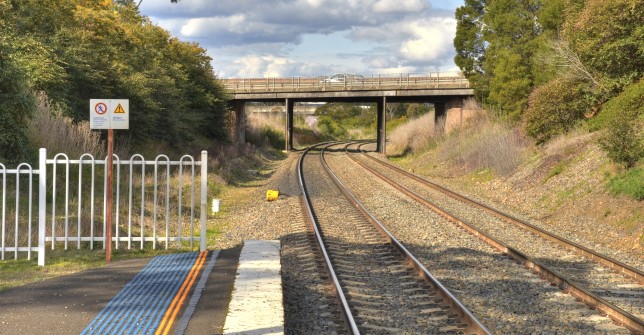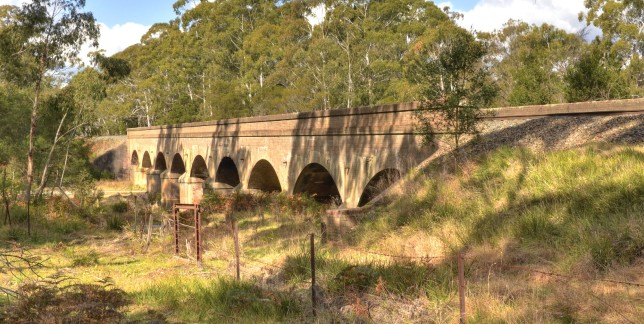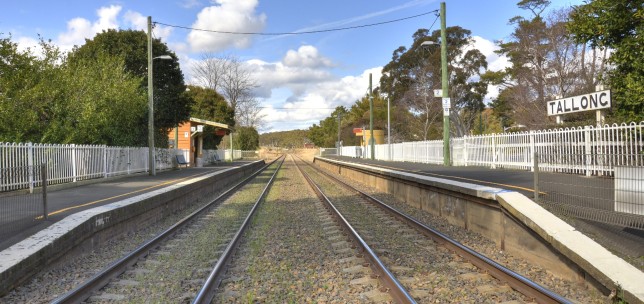← Towrang Previous | Next Bundanoon →
The Marulan sector consists of about half existing alignment and half new alignment around Uringalla. Prior to Tallong, a former alignment can be utilised which allows minimum radius of 2000m with few changes. Subsequently, the existing alignment has minimum radius ~500m, therefore a new alignment must be constructed. The country is undulating, meaning that significant earthworks and possibly some tunnelling and structures may be required.
Alignment design
Summary
The total cost of the sector is $145.0m over a length of 14.79km, coming to $9.80m/km. This is relatively expensive but it includes two upgraded stations and some rather difficult country on the eastern half, which has required substantial earthworks and importation of fill. The curve upon exit of Marulan is limited to about 2000m radius, which allows tilt-trains to transit at over 250km/h, and TGV-style trains to transit at about 240km/h. This is well sufficient for our purposes. The curve east of Tallong is about 3000m radius; given the limitation at Marulan, we do not need this large radius. A smaller radius of 2000m would allow us to avoid such a deep cutting, at the expense of a slightly longer section and an additional curve (dashed line). Assuming this allowed the third section to halve the depth of the cuttings, it would reduce earthwork cost from $19.4m to $9.8m. The sector would be about 250m longer, resulting in perhaps an extra $1m in track-related costs. The more complex alternative route therefore saves only about 6% on the baseline sector cost, therefore the superior 3000m radius option will be selected.
The earthworks balance over the sector is -137,100m3, meaning that this amount of fill will need to be imported from elsewhere; the large excavation at the exit from Goulburn (about 145,000m3) is a good candidate (there also may be suitable excavations at a closer distance in the subsequent sector). This excavation site is about 40km by road from the main fill sites in this sector, representing an additional mass-haulage cost of 137,100*30km*$2/km = $8.23m (remember that 5km of mass-haul is priced into both the excavation and fill cost assumptions). This may seem a lot, but if we assume a typical dump truck of about 12m3 capacity, we would need to do over 11,000 dump runs! That still comes out to about $720 per two-way run (80km), which shouldn’t take much more than an hour even with loading and unloading times accounted for. If we assume the round-trip takes 2 hours, that’s $360/hr truck hire, which is probably about right in Australia, sigh. At any rate, that is the assumption used by the government’s 2013 HSR study. For a different estimate, check out FreightMetrics – it tells me about $1844/day for a single tip-truck, which would be $230/hr for an 8-hr workday.
[table]
Component,Cost ($m),Percentage
Tunnels,0.0,0.0%
Bridges,1.2,0.8%
Earthworks,32.4,22.3%
Track,42.3,29.1%
S&C,25.9,17.8%
Civil works,34.2,23.6%
Stations,5.0,3.4%
Land,4.1,2.8%
TOTAL,145.0,100.0%
[/table]
1 – Marulan exit
Section length 2300m, sector start. The former alignment between Marulan and Medway Junction will be reinstated, although the corridor will still have to be reacquired. The most significant works will be the double grade separation at the Hume Highway. The railway can be constructed without redesign of the existing interchange.
- Earthworks: Perhaps 1000m of fill, estimate 2m average height
- $672k
- Track: assume all new track due to realignment of curve
- Upgrade 2 tracks, add 1: $5.76m
- 3 low-speed turnouts: $2.1m
- Signalling
- Cables and balises: $292k
- 2 crossover signals: $8m
- Civil works
- 1000m of steel palisade security fencing (within township): $100k
- 2600m of chainlink fence: $130k
- 300m of concrete barrier along highway on-ramp: $105k
- Drainage: $460k
- 2x major grade separations (one for each direction of Hume Hwy): $5m each
- Minor grade separation at George St: $1.25m
- 1x farm underpass: $500k
- Land
- 1600m of new 40m corridor required. Survey of realestate.com.au properties indicates a going rate of about $20,000/ha for small rural parcels in close proximity to the township.
- 6.4ha = $128k
- 1600m of new 40m corridor required. Survey of realestate.com.au properties indicates a going rate of about $20,000/ha for small rural parcels in close proximity to the township.
2 – Medway Junction to Tallong
Section length 5150m, starting at 2300m. Straight except for a very gentle curve just before the Barbers Creek bridge. The spur line to Medway quarry unfortunately joins the corridor on the wrong side; an expensive grade separation would be required to completely separate traffic. However the low volume of this line (serving only a single quarry) probably means we can get away with a double-crossover at-grade crossing. A single-lane bridge will be required at Barbers Creek in addition to the existing double-lane one; a bridge 80m in length with four spans should fit well. Although Tallong Station is too small to warrant a fast-rail stop, it is presently served by the intercity network and will require redevelopment to ensure this service can continue (the northern platform will need redesigning to accommodate a third track).
- Barbers Creek Bridge: 80m long with 20m spans: $1.19m
- Earthworks
- 1000m fill widening, 6m high: $576k
- 300m cut widening, 4m deep: $223k
- 600m fill widening, 4m high: $230k
- Track
- Dual upgrade + 1 new: $12.9m
- 2 low-speed turnouts: $1.4m
- Signalling
- Cables and balises: $654k
- Crossover signal for Medway spur: $4m
- Civil works
- 1200m of steel palisade fencing within township: $120k
- 9100m of chainlink fence: $455k
- 5150m of drainage: $1.03m
- 2 minor grade separations (1 farm driveway, plus Mulwaree Dr): $1.25m each
- Station
- Rebuild Tallong Station as minor regional halt. Assume same cost as rebuilding a closed station: $2.5m
- Land: Assume corridor must be widened by 6m (additional track)
- 3.1 ha, assume same acquisition cost as section 1: $61,800
3 – Uringalla Deviation
Section length 5390m, starting at 7450m. Exits the existing corridor to the south soon after Tallong (we will put in a turnout here to allow trains to use the old tracks when needed), then crossing a couple of creeks on culverted embankments. At Warrima Drive, either a tunnel or a deep cutting (25m deep at its deepest point) is necessary, followed by two large fills to cross a couple of creeks (the location is near the head of their catchments, therefore the flow will be small and bridges are not required, just culverts). An alternative route could deviate further to the south to avoid the deep cutting, but this would require a tighter radius (still >2000m though) and a second curve. Ends at the end of the second large fill.
- Tunnel (if used) would be 750m long and cost $46.5m. Obviously best to avoid it if we can!
- Earthworks
- 250m fill, 5m high: $390k
- 800m balanced cut/fill, avg 3m depth: $594k
- 400m fill, 5m high: $624k
- 1120m cut through rock, avg 12.5m deep: $10.63m
- 580m fill, 10m high: $2.51m
- 450m cut, 3m deep: $311k
- 760m fill, 12m high: $4.38m
- Mass-haul for fill shortfall: $8.23m
- Track
- 320m of upgraded dual track + 1 new: $802k
- 5070m of new dual track: $11.41m
- 2 low-speed turnouts: $1.4m
- Signalling
- Cables and balises: $685k
- Crossover signal: $4m
- Civil works
- 640m of security fence: $64k
- 10140m of chainlink fence: $507k
- 5390m of drainage: $1.08m
- 3x major culverts at creeks: $500k each
- 2x minor, complex grade separations (Railway Pde and Warrima Dv): $2.5m each
- Major grade separation over existing railway and Kareela Road: $5m
- Land: Assume new corridor required for 5km
- 20ha @ $20k/ha = $400k
- One house requires demolition: Assume $500k
4 – Wingello approach
Section length 1950m, starting at 12840m. Minor earthworks cutting across between Kemps Road and Kareela Drive, before rejoining on the north side of the existing alignment. Wingello Station will require a rebuild to accommodate triple track. The existing station building on the north side is a relatively simple but charming shelter, unstaffed, which would be desirable to keep. However if this is impractical, it can be replaced.
- Earthworks
- 500m cut, 8m deep: $2.48m
- 630m balanced cut/fill, 3m height: $468k
- 200m fill widening, 3m high: $58k
- Track
- 1950m of new dual track: $4.39m
- 3 low-speed turnouts: 2.1m
- Signalling
- Cable and balises: $248k
- Crossover signals: $8m
- Civil works
- 1540m of steel palisade security fencing: $154k
- 2360m of chainlink fence: $118k
- 1950m of drainage: $390k
- Minor, complex grade separation for Kareela Rd: $2.5m
- Minor, simple grade separation for Murrimba Rd: $1.5m
- Station
- Rebuild of Wingello Station: Assume $2.5m
- Land – mostly small blocks on edge of small township; assume $250,000/ha
- New corridor: 1500m @40m wide = 6ha, $1.5m
- 3 houses require demolition; assume $500k each









Interesting ideas but…
Freight traffic through the Marulan- Moss Vale area will certainly not fit on a single track- 51 freight services per day currently scheduled.
On a broader scale, relegating freight to the present line with no improvements, even if double track, makes little sense. Australian non suburban/interurban railways are basically freight railways and to lock them into a regime of no improvement continues to impose slow, uncompetitive schedules for containers etc, and high costs (flange & rail wear resulting from tight curves and high fuel costs) on ALL freight.
Hi John,
I agree with you that the current alignment of the Main Southern Railway is sub-optimal for both freight and passengers; my aim with the Hot Rails strategy is to upgrade the existing tracks for passenger use, with freight admittedly being an afterthought. Nevertheless I would argue freight would certainly benefit under my plan – it would go from double-track, shared with passenger services, to single dedicated track with frequent, long passing loops (remember that the frequent sections double track bypassed by the passenger railway would still be available for dedicated freight use). Scott’s Formula indicates that 50 movements per day could be accomodated with a maximum block length of about 25 minutes – this should be easily achievable on the current line, perhaps with a few additional passing loops thrown into the mix.
Of course the ideal solution as you imply would be for the entire line to be replaced with a new alignment designed specifically for modern freight trains. I agree, but argue that the existing line (which passes through dozens of townships and residential areas) is much better suited to an upgraded passenger railway than an upgraded freight railway. We really are in a bizarre position in Australia where we are proposing new passenger rail that bypasses all the towns (HSR study 2013) while the proposed new freight rail will pass right through the middle of them (Inland Rail).
The ideal solution would be to follow the German approach and design a new line suitable for both fast passenger trains and intermodal freight. Electrically-hauled double-stack intermodal freight should be able to comfortably cruise at 115–140 km/h without any problems at all, and if passenger trains run at 200–240 km/h the speed differential should be manageable provided there is adequate provision of passing lanes using high-speed turnouts. I think the thing that the various studies are missing is that it’s not maximum speed that matters so much as average speed; if we could design a new rail corridor that permits passenger averages of 180–210 km/h and freight averages ~100 km/h, rail would become competitive with both road and air especially once carbon pricing schemes take effect. Let’s face it, we’re going to need every trick in the box to reduce dependency on fossil fuels.
Sydney to Melbourne is a bit under 900 km on the current Hume Highway alignment, and a modern rail alignment with stricter geometry should be able to reduce that to about 860–870 km. Averaging 200 km/h, end-to-end journeys are about 4½ hours, which is only marginally longer than flying once you take into account CBD–airport transfers and waiting times. If freight services could do the journey at an average of 100 km/h, the journey time gets slashed from the current 13.5 hours to less than 8 hours. There’s no new technology required to achieve this, either: high speed freight locomotives have been used successfully in Europe for over two decades, and it wouldn’t be difficult to modify freight rollingstock to use better bogies with ECP braking with disk brakes. Rather than follow the American lead with freight trains, using long, slow, and infrequent diesel-hauled trains, we could adopt what the Europeans are proposing with fast, more frequent, medium-length freight trains.